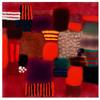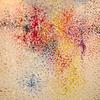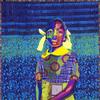Vik Muniz: Photography and the Rebirth of Wonder
- NORFOLK, Virginia
- /
- May 31, 2018
The Chrysler Museum of Art will unveil a major retrospective of photographs by celebrated contemporary artist Vik Muniz this summer. Vik Muniz: Photography and the Rebirth of Wonder will be on view from July 13 –Oct. 14, 2018. Curated by Arthur Ollman of the Foundation for the Exhibition of Photography, the exhibition explores the full breadth of the imaginative artist’s career with more than 100 photographs, including many of Muniz’s most recent works.
Born in 1961 in São Paulo, Brazil, Muniz is widely recognized as one of the most innovative and creative artists working today. He creates what he calls “photographic delusions” that playfully investigate visual memory and human perception. Muniz’s works begin as sculptural assemblages made from an array of unconventional materials like chocolate syrup, tomato sauce, magazine clippings, dust, trash and diamonds. He then records these creations in sharp detail with a camera.
The resulting photographic images often resemble familiar scenes from pop culture or masterpieces from the history of art while drawing attention to our own process of decoding visual information. His recent work utilizes electron microscopes, lasers and manipulated microorganisms to unveil both the familiar and the strange in spaces that are typically inaccessible to the human eye.
“Muniz has devoted his creative energies to playfully questioning what our eyes take for granted,” said Seth Feman, Ph.D, Curator of Exhibitions and Curator of Photography at the Chrysler. “The inviting and accessible works meditate on human perception and optics, helping us think about how we see, how we remember and how we’ve come to trust our eyes.”
The exhibition is the most comprehensive retrospective of the artist’s work to date and includes examples from nearly every stage of Muniz’s career. Early works include examples from his Sugar Children series, for which the artist created portraits of the children of sugarcane farmers after visiting St. Kitts in 1996. The portraits are made from sugar crystals spread across black paper, using the visual and symbolic qualities of the material to convey the children’s vibrant energy.
Other early works similarly engage the relationship between form and meaning. These include Hollywood divas made from diamonds, a portrait of Cuban revolutionary Che Guevara made from black beans, images of Jackson Pollock and Sigmund Freud made from messy drabs of chocolate syrup, and the Mona Lisa made from peanut butter and jelly. Up close, the photographs display fragmentary arrangements of everyday objects. Viewed from afar, the objects come to order, bearing an uncanny resemblance to recognizable images.
“Muniz’s works invite a sort of dance and compel you to move your body, drawing attention to the physicality of vision,” Feman said.
For his Sand Castles series, Muniz built the world’s smallest sandcastles using a scanning electron microscope to etch microdrawings of castles on individual grains of sand. The resulting photographs demonstrate his ongoing interest in experimentations with scale; the drawings are less than half a millimeter in length, but the final photographs are many feet tall.
The exhibition also includes recent large photographs created using thousands of found snapshots of unknown people. Muniz arranges these to reference images from his own family albums, suggesting how changes in technology and the rise of digital photography have made family images less treasured and more commonplace. The photographs speak to the impact of these shifts on experience and memory.
Muniz collaborated with scientists from the Massachusetts Institute of Technology for his Colonies series. The works employ microorganisms, including bacteria and cancer cells, to multiply in choreographed designs. In these photographs, Muniz morphs the frightening into the beautiful, producing striking, intricate patterns from materials with largely negative connotations. Like many of Muniz’s works, the Colonies photographs bring attention to social issues. In this case, he highlights the importance of medical research and vaccination.
Museum visitors will also see some of Muniz’s most recognized works, including pieces from his Pictures of Garbage series, which was explored in the acclaimed documentary Waste Land. The award-winning documentary was filmed over nearly three years and follows Muniz as he works with the catadores, or trash pickers, of Jardim Gramacho, a 321-acre dump near Rio de Janeiro that closed in 2012. The catadores made a living by sorting through the garbage in the enormous open-air landfill, and Muniz collaborated with the group to create large-scale photographic portraits of the workers, often posed as recognizable works of art. The portraits were then recreated with assembled trash and photographed. The images were sold at auction for $250,000, much of which went to the catadores union to build a library, retrain workers when the landfill closed and more.
Muniz’s works are stimulating for visitors of all ages, and the exhibition will include a selection of labels for young readers. Additionally, the exhibition will include a hands-on activity inspired by many of the processes Muniz uses in his work. Visitors can photograph their own creations and share them on social media.
Vik Muniz grew up in a poor working-class environment and showed early aptitude for drawing. His school lecture notes were most often composed of drawings of the presented material. Following an accidental shooting in which Muniz was injured, he received a legal settlement that afforded him the chance to study art in the United States. Over the past two decades, Muniz’s work has been exhibited in museums and galleries worldwide and is currently included in the collections of major international museums including the Chrysler Museum of Art; the Art Institute of Chicago; Museum of Contemporary Art, Los Angeles; The J. Paul Getty Museum; The Metropolitan Museum of Art; The Museum of Modern Art, New York; Museu de Arte Moderna de São Paulo; the Victoria and Albert Museum in London; and the High Museum of Art, among others. Muniz was commissioned by the Metropolitan Transportation Authority to contribute artwork for the 72nd St. and 2nd Ave. subway station in New York, which was unveiled to the public in 2017.
In addition to his artistic activities, Muniz is involved in educational and social projects in Brazil and the United States. Waste Land (2010), a documentary profiling his work, was nominated for an Academy Award and won the Sundance Film Festival Audience Award for Best Film. In 2011, UNESCO nominated him Goodwill Ambassador, and in January 2013 he received the Crystal Award from the World Economic Forum. In 2014 Muniz finished building Escola Vidigal, a school of art and technology for low-income children from the Vidigal community in Rio de Janeiro. He has also been a guest speaker at major universities and museums such as University of Oxford; Harvard University; Yale University; the TED Conference; New York University; the International Center of Photography; The Museum of Modern Art, New York; Museu de Arte Moderna de São Paulo; Museum of Fine Arts, Boston; Massachusetts Institute of Technology; the High Museum of Art; and the World Economic Forum in Davos, Switzerland, among others. Muniz lives and works in New York and Rio de Janeiro.
This exhibition is co-organized by the Foundation for the Exhibition of Photography, Minneapolis/New York City/Paris/Lausanne, and the High Museum of Art, Atlanta.















